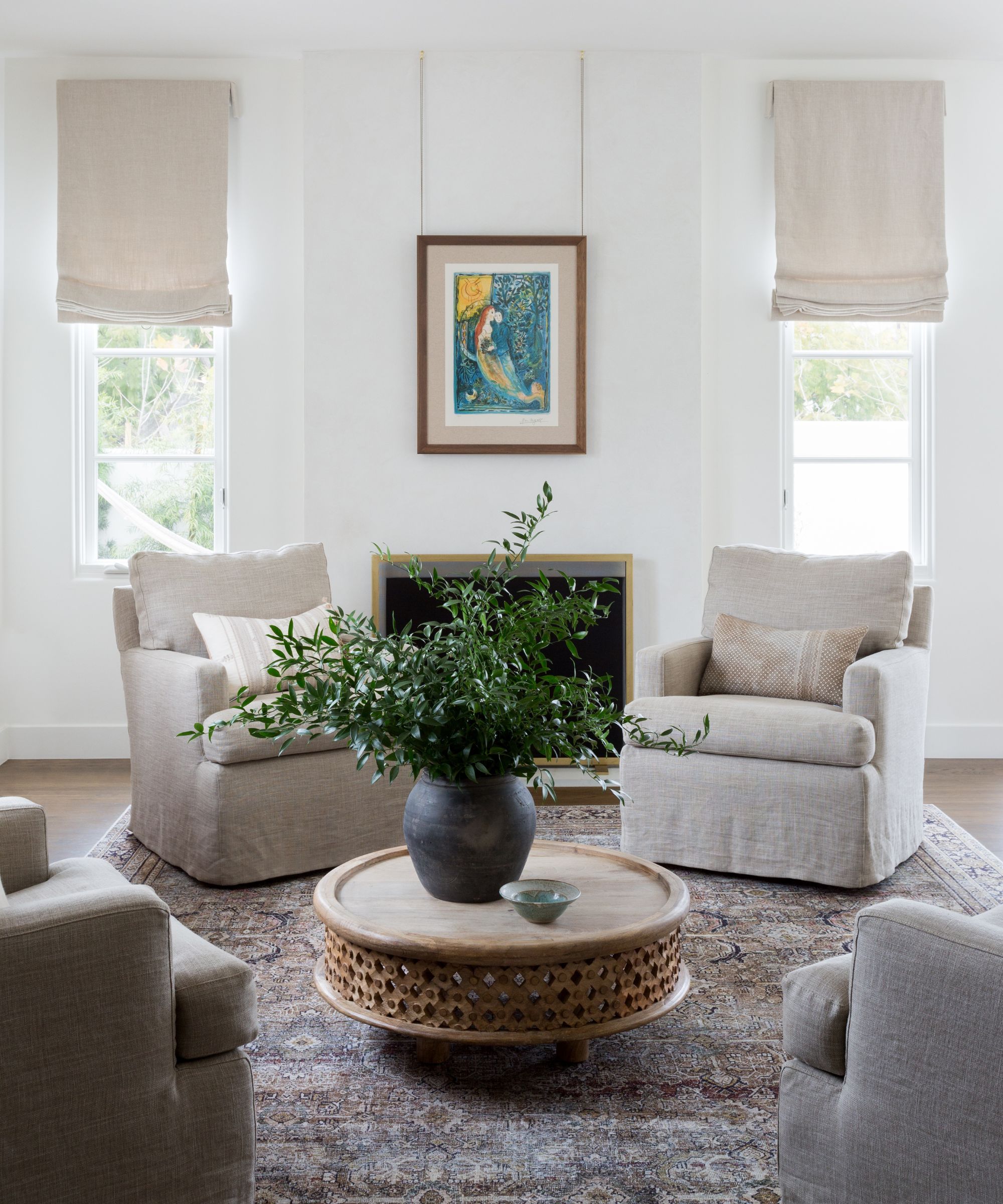Does a living room always need a sofa? The verdict from designers may surprise you
Discover if interiors professionals think a living room sofa is a must-have, or just one option


Comfortable seating is a must in a space shared with family and friends, but does that mean a living room always needs a sofa? After all, there are other seating options out there.
Think living room ideas and typically they’ll include a couch, of course, no matter the size, dimensions, or style of room that’s favored. But maybe that’s just convention rather than an essential? Perhaps armchairs, daybeds, chaise longues and more might make for a more appealing and elegant combination for some rooms.
We asked interior designers to give us their verdicts on whether a sofa is always vital for seating and as a centerpiece for a living room, or if that’s not always the case, and this is what they said.
Does a living room always need a sofa?
The verdict from the experts? A living room doesn’t always need a sofa, but it does have a whole raft of advantages.
‘While a sofa can be a staple in many living rooms, it’s not an absolute necessity,’ says Devin Shaffer, lead interior designer at Decorilla. ‘Interior design is about creating spaces that reflect your own lifestyle and needs. It’s essential to consider the specific context and requirements of each living room before deciding whether a sofa is the best choice or if alternative seating arrangements could better serve the space and your own style.’
Interior designer Yuuna Morishita agrees that the answer to the question of whether a living room always needs a sofa is not necessary. ‘The choice depends on the room’s purpose, size, and a person’s lifestyle,’ she says. ‘A daybed or comfortable armchairs might be more appropriate if the living room is more for personal relaxation than socializing. A sofa may not be essential for folks who prefer minimalist and non-traditional designs.’
But it can be the top option in some circumstances, points out Luis Carmona, owner and lead designer at VERDE Interior Design. ‘Using the word “always” in design is bold since interior design is quite subjective at times,’ he says. ‘However, most would agree that living rooms are there to be lived in and that includes entertaining guests, watching TV, or lounging with family.
Design expertise in your inbox – from inspiring decorating ideas and beautiful celebrity homes to practical gardening advice and shopping round-ups.
‘If there is an additional family room available where these types of activities can be held, then a living room does not necessarily have to contain a sofa,’ he continues. ‘If the living room is the only place where one can watch TV with the family or entertain guests, then I would strongly suggest including a sofa as part of the design of the room.’
Let this advice from design professionals help you decide whether living room sofa ideas are what you need or whether a different choice is preferable.
Benefits of a living room sofa

Using a sofa as part of your living room furniture ideas is a great idea for many reasons.
‘One of the key elements to a fully functional living room is adequate seating,’ says Luis Carmona. ‘A well-sized sofa in a space provides just that. Utilizing a sofa in a living room is one of the easiest and most common methods to provide ample seating in a space.’
Interior designer Artem Kropovinsky agrees. ‘Socializing is made easy on sofas while they bring comfort into any surroundings,’ he says. ‘Your favorite materials become the background for you and it’s like a blank canvas.’
A sofa is space-efficient. ‘One of the biggest advantages of a sofa is the comfort of entertaining larger groups,’ says Alice Cheng, principal of Shialice Spatial Design, a full-service interior design studio based in Los Angeles. ‘They simply provide more seats in the same amount of space.’
Sofas can fulfill additional functions, points out Devin Shaffer. ‘They can be used for a lot of different purposes, such as sleeping and there are even those with storage inside,’ he says.
A sofa can also make the living room layout a more straightforward process. ‘Because a sofa is, oftentimes, the largest piece of furniture in a room, it acts as an anchor piece that grounds the rest of the room,’ says Luis. ‘This allows for smaller pieces like accent tables, side chairs and lighting to feel cohesive in the space despite their different size, shape and surface texture.
‘Due to its larger size, sofas also are great to frame out or divide a living room,’ he adds. ‘They can be used to help redirect traffic lines in a room, which are the paths that most people take to navigate, enter, or exit the room.
‘The larger size of the sofa also helps bring balance to a room and creates harmony between many smaller items and a larger piece,’ he says.
‘While a living room can be curated with an array of other pieces, a sofa does tend to serve as a focal point and is fundamental for the space,’ agrees NYC-based interior designer Paris Forino. ‘Sofas are also quite necessary as they offer versatility, whether you are laying down or your guests are convening comfortably. It’s truly a centerpiece for a living room.’

Based in New York, Artem Kropovinsky boasts extensive global design experience spanning a decade. With a commitment to sustainability and authenticity, Artem, alongside his dedicated team, undertakes projects both in the US and internationally, earning recognition through prestigious design awards. Artem is the founder of Arsight, an esteemed global design firm known for its expertise in residential and commercial interior design.
Benefits of alternative seating choices

Interior designers see a whole lot of upsides in choosing a sofa for the living room but, it isn’t always the right choice.
Going without a sofa can promote sociability. ‘Depending on the space, I love using daybeds and larger lounge chairs to create more intimate sitting arrangements where people can be facing one another in conversation,’ says Alice Cheng. ‘This is especially nice when there’s no TV in the room and not a clear need for everyone to be facing the same direction.’
Artem Kropovinsky agrees: ‘For chats think armchairs and for lounging think daybeds, while modular seating allows for an ever-changing layout,’ he says.
Some room sizes and shapes might be better off without a sofa. ‘In smaller or unusually shaped rooms, a large sofa might overwhelm the space,’ advises Yuuna Morishita. ‘Alternative seating can offer flexibility and better use of space.’
Devin Shaffer agrees. ‘Going for an armchair, ottoman, floor cushions, daybeds or modular seating can offer more dynamism and a better use of the space,’ he says. ‘These will allow you to come up with creative arrangements for various social settings and personal preferences.’
For a great room design with seating other than a sofa, Yuuna also recommends placing items so they’re opposite one another, or placing chairs in a semi-circle. ‘Incorporate a central piece like a coffee table or an area rug to anchor the arrangement,’ she says.
FAQs
What type of couch is best for a small living room?
To buy the right couch for a small living room you may need a different approach from that taken when choosing for a more generously sized room. ‘Some smaller living rooms might not be able to fit a standard size sofa longer than 72 inches,’ says Alice Cheng, principal of LA-based studio Shialice Spatial Design. ‘That’s when smaller pieces like daybeds or more petite options like settees can come into play.’
Alternatively, the room might accommodate a different sofa shape or design. ‘Armless sofas tend to take up less space while sofas with a curved design are suitable for smaller or oddly shaped rooms,’ says Luis Carmona, owner and lead designer at VERDE Interior Design. ‘They also tend to fit better in a corner which would open up more of the space in the center of the room for other design items.’
A sofa is often the right choice for a living room, but it’s not invariably the case. Whichever seating you choose, give the space maximum chic by styling a living room like a pro. And make sure it feels spacious whatever its size with the golden rules for a clutter-free living room.

Sarah is a freelance journalist and editor. Previously executive editor of Ideal Home, she’s specialized in interiors, property and gardens for over 20 years, and covers interior design, house design, gardens, and cleaning and organizing a home for Homes & Gardens. She’s written for websites, including Houzz, Channel 4’s flagship website, 4Homes, and Future’s T3; national newspapers, including The Guardian; and magazines including Future’s Country Homes & Interiors, Homebuilding & Renovating, Period Living, and Style at Home, as well as House Beautiful, Good Homes, Grand Designs, Homes & Antiques, LandLove and The English Home among others. It’s no big surprise that she likes to put what she writes about into practice, and is a serial house renovator.